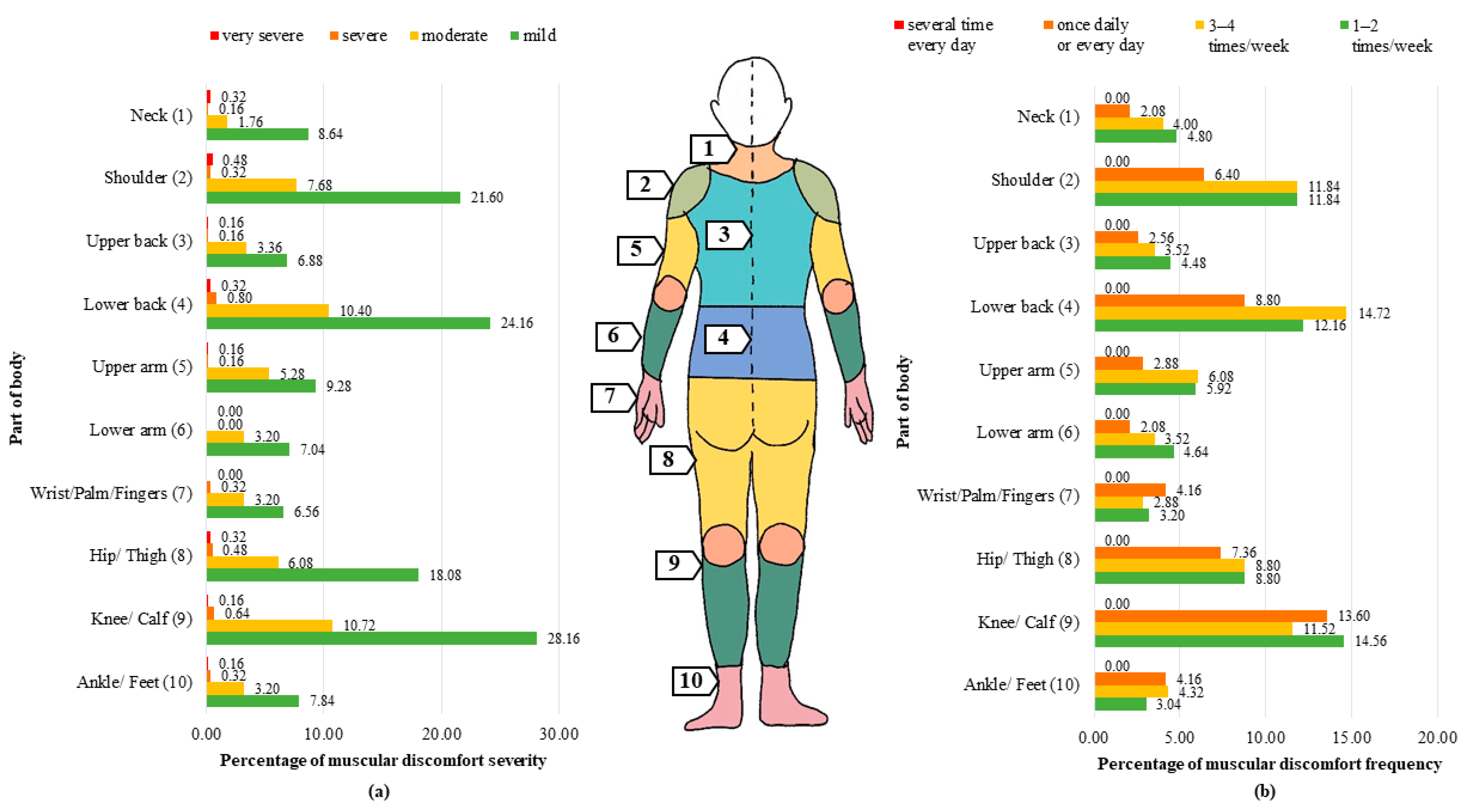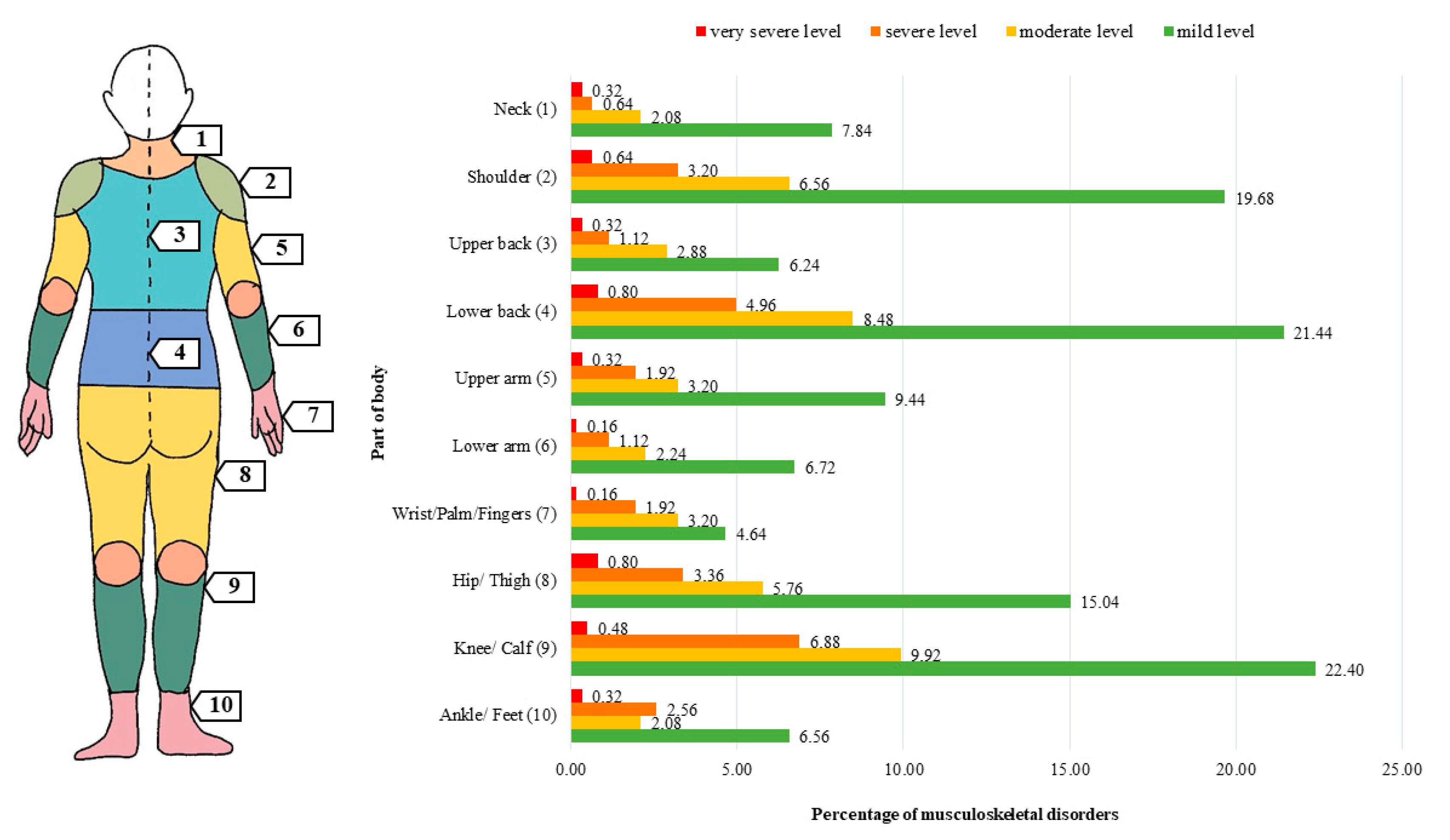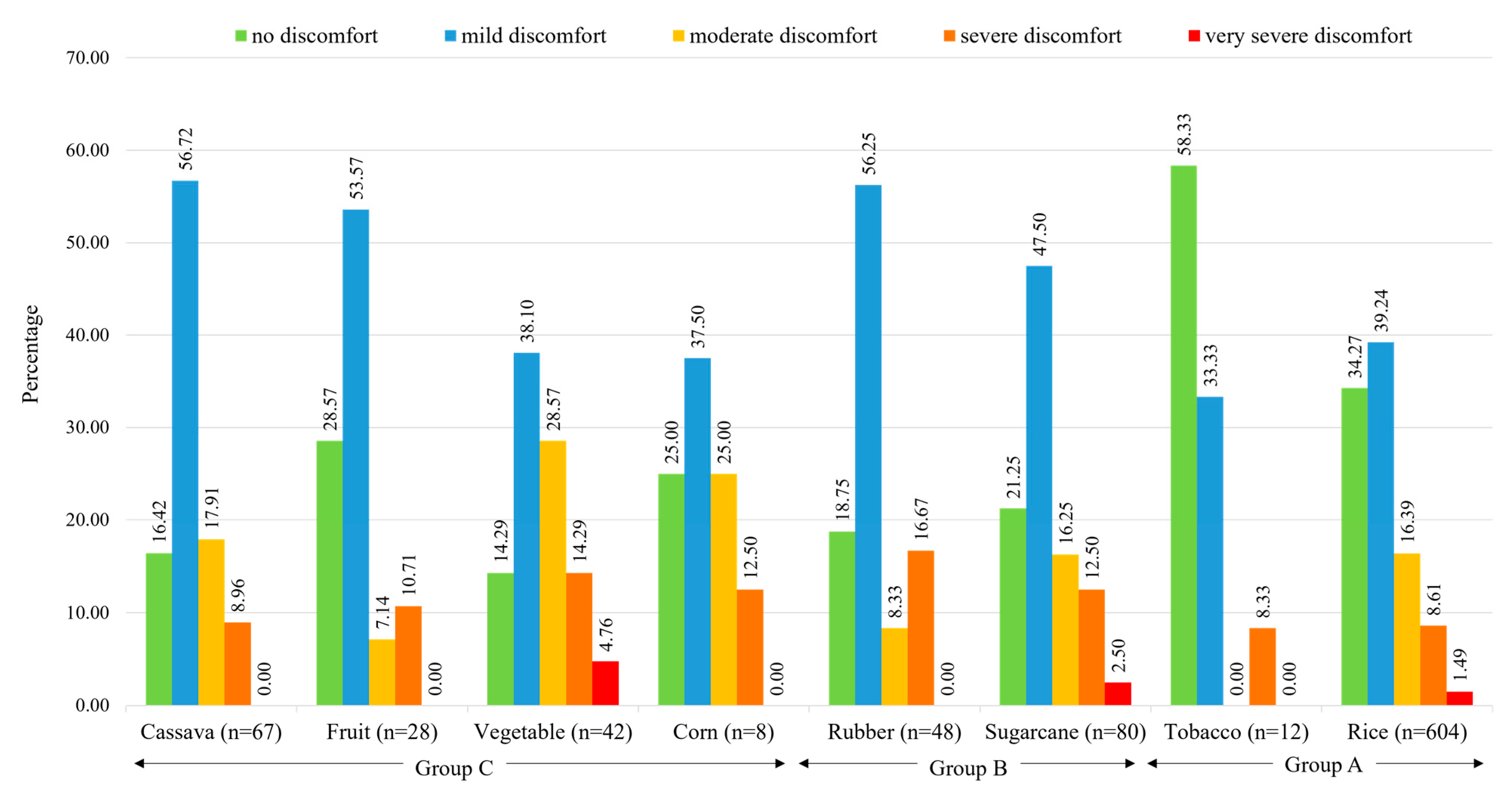Musculoskeletal Disorders among Agricultural Workers of Various Cultivation Activities in Upper Northeastern Thailand
Abstract
:1. Introduction
2. Materials and Methods
2.1. Study Design
2.2. Recruitment and Sampling Strategy
- (1)
- Randomly selecting a district in each province;
- (2)
- Then, randomly selecting sub-districts in each selected district;
- (3)
- Finally, randomly selecting the health-promoting hospital in each sub-district.
2.3. Structure Questionnaire
- level 0 (0 points) = no MSDs;
- level 1 (1–2 points) = mild MSDs;
- level 2 (3–4 points) = moderate MSDs;
- level 3 (5–8 points) = severe MSDs;
- level 4 (9–16 points) = very severe MSDs.
2.4. Data Collection
2.5. Statistical Analyses
3. Results
3.1. Demographic Characteristics and Types of Tasks Performed
3.2. MSDs Levels
4. Discussion
5. Conclusions
Supplementary Materials
Author Contributions
Funding
Institutional Review Board Statement
Informed Consent Statement
Data Availability Statement
Acknowledgments
Conflicts of Interest
References
- National Statistical Office, Thailand, 2021. The Repot of Informal Workers Survey. Available online: http://www.nso.go.th/sites/2014/DocLib13/ด้านสังคม/สาขาแรงงาน/Informal_work_force/2564/summary_64.pdf (accessed on 23 December 2021).
- National Statistical Office. 2013. Preliminary Report 2013 Agricultural Census. Bangkok Thailand: Statistical Forecasting Di-vision. Available online: http://www.nso.go.th/sites/2014/Documents/Agri/2556/reports/Agri_Preliminary.pdf (accessed on 23 December 2021).
- Chaiklieng, S.; Poochada, W.; Suggaravetsiri, P. Work-related diseases among agriculturists in Thailand: A systematic review. Songklanakarin J. Sci. Technol. 2021, 43, 638–647. [Google Scholar]
- Peungsuwan, P.; Chatchawan, U.; Puntumetakul, R.; Yamauchi, J. The prevalence and work-related physical factors associated with knee pain in older Thai farmers. J. Phys. Ther. Sci. 2019, 31, 466–469. [Google Scholar] [CrossRef] [PubMed]
- Kaewdok, T.; Sirisawasd, S.; Taptagaporn, S. Agricultural risk factors related musculoskeletal disorders among older farmers in Pathum Thani province, Thailand. J. Agromed. 2021, 26, 185–192. [Google Scholar] [CrossRef] [PubMed]
- Gadhavi, B.; Shukla, Y. Prevalence of work related musculoskeletal disorders in farmers of Gujarat. Int. J. Res. Rev. 2019, 6, 231–236. [Google Scholar]
- Sombatsawat, E.; Luangwilai, T.; Ong-artborirak, P.; Siriwong, W. Musculoskeletal disorders among rice farmers in Phimai district, Nakhon Ratchasima province, Thailand. J. Health Res. 2019, 33, 494–503. [Google Scholar] [CrossRef]
- Karukunchit, U.; Puntumetakul, R.; Swangnetr, M.; Boucaut, R. Prevalence and risk factor analysis of lower extremity abnormal alignment characteristics among rice farmers. Patient Prefer. Adherence 2015, 9, 785–795. [Google Scholar] [CrossRef]
- Neubert, M.S.; Karukunchit, U.; Puntumetakul, R. Identification of influential demographic and work-related risk factors associated to lower extremity pain perception among rice farmers. Work 2017, 58, 489–498. [Google Scholar] [CrossRef]
- Keawnual, A.; Lohapoontagoon, B.; Pochana, K. Prevalence of work-related musculoskeletal disorders in various occupations. Public Health J. Burapha Univ. 2007, 23, 297–303. [Google Scholar]
- Mahto, P.K.; Gautam, B. Prevalence of work-related musculoskeletal disorders in agricultural farmers of Bhaktapur district, Nepal. Int. J. Occup. Saf. Health 2018, 8, 3–7. [Google Scholar] [CrossRef]
- Thetkathuek, A.; Meepradit, P.; Sa-ngiamsak, T. A cross-sectional study of musculoskeletal symptoms and risk factors in Cambodian fruit farm workers in eastern region, Thailand. Saf. Health Work 2018, 9, 192–202. [Google Scholar] [CrossRef]
- Chaiklieng, S. Health risk assessment on musculoskeletal disorders among potato-chip processing workers. PLoS ONE 2019, 14, e0224980. [Google Scholar] [CrossRef] [PubMed]
- Khanaphan, K.; Suggaravetsiri, P.; Chaiklieng, S. Ergonomics risk and muscle fitness among rubber planters in Ubon Ratchathani province. UBRU J. Public Health Res. 2019, 8, 21–31. [Google Scholar]
- Homsombat, T.; Chaiklieng, S. Physical fitness and muscular discomfort among informal garment female workers in Udon Thani province, Thailand. J. Med. Assoc. Thai. 2017, 100, 230–238. [Google Scholar] [PubMed]
- Chaiklieng, S.; Suggaravetsiri, P.; Stewart, J. Incidence and risk factors associated with lower back pain among university office workers. Int. J. Occup. Saf. Ergon. 2021, 27, 1215–1221. [Google Scholar] [CrossRef] [PubMed]
- Chaiklieng, S.; Phuengsangpaen, S.; Suggaravetsiri, P.; Trinnawoottipong, K. The prevalence and severity of occupational diseases among field crop farmers in Nongbualamphu Province. J. Off. DPC 7 Khon Kaen 2019, 26, 77–86. [Google Scholar]
- Chaiklieng, S.; Chagkornburee, C.; Suggaravetsiri, P. Situations of work-related diseases and injuries among agriculturists in the upper northeast regions of Thailand [version 1; peer review: 1 approved with reservations]. F1000Research 2022, 11, 145. [Google Scholar] [CrossRef]
- Jirawatkul, A. Statistics for Health Science Research; Wittayapat: Bangkok, Thailand, 2009. [Google Scholar]
- Puntumetakul, R.; Siritaratiwat, W.; Boonprakob, Y.; Eungpinichpong, W.; Puntumetakul, M. Prevalence of musculoskeletal disorders in farmers: Case study in Sila, Muang Khon Kaen, Khon Kaen province. J. Med. Tech. Phy. Ther. 2011, 23, 297–303. [Google Scholar]
- Rachmi, I.M.; Werdhani, R.A.; Murdana, I.N. Association of knee pain with working position and other factors among dairy farmers: A study in West Java, Indonesia. The 2nd Physics and Technologies in Medicine and Dentistry Symposium. IOP Conf. Ser. J. Phys. Conf. Ser. 2018, 1073, 042011. [Google Scholar] [CrossRef]
- Reid, C.R.; Bush, P.M.; Karwowski, W.; Durrani, S.K. Occupational postural activity and lower extremity discomfort: A review. Int. J. Ind. Ergon. 2010, 40, 247–256. [Google Scholar] [CrossRef]
- Keawduangdee, P.; Puntumetakul, R.; Swangnetr, M.; Laohasiriwong, W.; Settheetham, D.; Yamauchi, J.; Boucaut, R. Prevalence of low back pain and associated factors among farmers during the rice transplanting process. J. Phys. Ther. Sci. 2015, 27, 2239–2245. [Google Scholar] [CrossRef]
- Fulmer, S.; Punnett, L.; Slingerland, D.; Earle-Richardson, G. Ergonomic exposures in apple harvesting: Preliminary observations. Am. J. Ind. Med. Suppl. 2002, 2, 3–9. [Google Scholar] [CrossRef] [PubMed]
- Hasheminejad, N.; Choobineh, A.; Mostafavi, R.; Tahernejad, S.; Rostami, M. Prevalence of musculoskeletal disorders, ergonomics risk assessment and implementation of participatory ergonomics program for pistachio farm workers. Med. Lav. 2021, 112, 292–305. [Google Scholar] [CrossRef] [PubMed]
- Houshyar, E.; Kim, I. Understanding musculoskeletal disorders among Iranian apple harvesting laborers: Ergonomic and stop watch time studies. Int. J. Ind. Ergon. 2018, 67, 32–40. [Google Scholar] [CrossRef]




| Characteristic | Number (%) | |||||||
|---|---|---|---|---|---|---|---|---|
| Group A | Group B | Group C | ||||||
| Rice (n = 604) | Tobacco (n = 12) | Rubber (n = 48) | Sugarcane (n = 80) | Cassava (n = 67) | Fruit (n = 28) | Vegetable (n = 42) | Corn (n = 8) | |
| Gender | ||||||||
| Male | 247 (40.89) | 11 (91.67) | 10 (20.83) | 22 (27.50) | 26 (38.81) | 14 (50.00) | 9 (21.43) | 2 (25.00) |
| Female | 357 (59.11) | 1 (8.33) | 38 (79.17) | 58 (72.50) | 41 (61.19) | 14 (50.00) | 33 (78.57) | 6 (75.00) |
| Age (years) | ||||||||
| ≤40 | 24 (3.97) | 0 (0.00) | 10 (20.83) | 14 (17.50) | 4 (5.97) | 2 (7.14) | 2 (4.76) | 1 (12.50) |
| 41–50 | 109 (18.05) | 5 (41.67) | 15 (31.25) | 25 (31.25) | 22 (32.84) | 3 (10.71) | 9 (21.43) | 1 (12.50) |
| 51–60 | 228 (37.75) | 3 (25.00) | 12 (25.00) | 29 (36.25) | 25 (37.31) | 12 (42.86) | 12 (28.57) | 3 (37.50) |
| ≥61 | 243 (40.23) | 4 (33.33) | 11 (22.92) | 12 (15.00) | 16 (23.88) | 11 (39.29) | 19 (45.24) | 3 (37.50) |
| Mean (sd) | 57.08 (9.75) | 48.5 (6.00) | 49.78 (11.11) | 50.41 (10.76) | 53.58 (8.54) | 57.82 (10.21) | 56.31 (11.65) | 57 (11.62) |
| Min, Max | 21, 80 | 42, 66 | 28, 80 | 20, 79 | 36, 70 | 33, 75 | 27, 76 | 38, 73 |
| Career | ||||||||
| Self-employed | 554 (91.72) | 12 (100.00) | 43 (89.58) | 70 (87.50) | 63 (94.03) | 27 (96.43) | 39 (92.86) | 7 (87.50) |
| Cultivation worker | 27 (4.47) | 0 (0.00) | 5 (10.42) | 10 (12.50) | 4 (5.97) | 1 (3.57) | 2 (4.76) | 1 (12.50) |
| Others | 23 (3.81) | 0 (0.00) | 0 (0.00) | 0 (0.00) | 0 (0.00) | 0 (0.00) | 1 (2.38) | 0 (0.00) |
| Area of Discomfort according to Cultivation Type | n | Muscular Discomfort | OR | 95% CI | p-Value | |
|---|---|---|---|---|---|---|
| Yes (%) | No (%) | |||||
| Shoulders | ||||||
| Group A | 616 | 123 (19.97) | 493 (80.03) | 1.00 | ||
| Group B | 128 | 26 (20.31) | 102 (79.69) | 1.02 | 0.64–1.64 | 0.929 |
| Group C | 145 | 39 (26.90) | 106 (73.10) | 1.47 | 0.97–2.24 | 0.068 |
| Lower back | ||||||
| Group A | 616 | 152 (24.68) | 464 (75.32) | 1.00 | ||
| Group B | 128 | 33 (25.78) | 95 (74.22) | 1.06 | 0.68–1.64 | 0.792 |
| Group C | 145 | 38 (26.21) | 107 (73.79) | 1.08 | 0.72–1.64 | 0.702 |
| Hip/thigh | ||||||
| Group A | 616 | 102 (16.56) | 514 (83.44) | 1.00 | ||
| Group B | 128 | 23 (17.97) | 105 (82.03) | 1.10 | 0.67–1.82 | 0.698 |
| Group C | 145 | 31 (21.38) | 114 (78.62) | 1.37 | 0.87–2.15 | 0.170 |
| Knee/calf | ||||||
| Group A | 616 | 146 (24.19) | 467 (75.81) | 1.00 | ||
| Group B | 128 | 43 (33.59) | 85 (66.41) | 1.59 | 1.05–2.39 | 0.028 * |
| Group C | 145 | 56 (38.62) | 89 (61.38) | 1.97 | 1.35–2.89 | <0.001 * |
| Lower limbs | ||||||
| Group A | 616 | 217 (35.23) | 399 (64.77) | 1.00 | ||
| Group B | 128 | 57 (44.53) | 71 (55.47) | 1.48 | 1.01–2.17 | 0.048 * |
| Group C | 145 | 75 (51.72) | 70 (48.28) | 1.97 | 1.37–2.84 | <0.001 * |
| Rice Processing Activity | n | Number Experiencing Muscular Discomfort (%) | |||
|---|---|---|---|---|---|
| Shoulders | Hips/Thighs | Knees/Calves | Lower Limbs | ||
| Rice field ploughing | 12 | 2 (16.67) | 3 (25.00) 3 | 5 (41.67) 2 | 7 (58.33) 1 |
| Rice seeding | 153 | 45 (29.41) 3 | 29 (18.95) | 51 (33.33) 2 | 75 (49.02) 1 |
| Rice planting | 160 | 14 (8.75) | 19 (11.88) 3 | 31 (19.38) 2 | 41 (25.62) 1 |
| Rice plucking | 47 | 9 (19.15) 3 | 8 (17.02) | 14 (29.79) 2 | 19 (40.43) 1 |
| Rice bag spraying | 27 | 6 (22.22) 3 | 4 (14.81) | 9 (33.33) 2 | 11 (40.74) 1 |
| Rice harvesting | 155 | 32 (20.65) 2 | 31 (20.00) 3 | 28 (18.06) | 49 (31.61) 1 |
| Rice mowing | 32 | 8 (25.00) 2 | 6 (18.75) 3 | 8 (25.00) 2 | 10 (31.25) 1 |
| Rice bag carrying | 18 | 5 (27.78) 1 | 1 (5.56) | 2 (11.11) 3 | 3 (16.67) 2 |
Publisher’s Note: MDPI stays neutral with regard to jurisdictional claims in published maps and institutional affiliations. |
© 2022 by the authors. Licensee MDPI, Basel, Switzerland. This article is an open access article distributed under the terms and conditions of the Creative Commons Attribution (CC BY) license (https://creativecommons.org/licenses/by/4.0/).
Share and Cite
Poochada, W.; Chaiklieng, S.; Andajani, S. Musculoskeletal Disorders among Agricultural Workers of Various Cultivation Activities in Upper Northeastern Thailand. Safety 2022, 8, 61. https://doi.org/10.3390/safety8030061
Poochada W, Chaiklieng S, Andajani S. Musculoskeletal Disorders among Agricultural Workers of Various Cultivation Activities in Upper Northeastern Thailand. Safety. 2022; 8(3):61. https://doi.org/10.3390/safety8030061
Chicago/Turabian StylePoochada, Worawan, Sunisa Chaiklieng, and Sari Andajani. 2022. "Musculoskeletal Disorders among Agricultural Workers of Various Cultivation Activities in Upper Northeastern Thailand" Safety 8, no. 3: 61. https://doi.org/10.3390/safety8030061
APA StylePoochada, W., Chaiklieng, S., & Andajani, S. (2022). Musculoskeletal Disorders among Agricultural Workers of Various Cultivation Activities in Upper Northeastern Thailand. Safety, 8(3), 61. https://doi.org/10.3390/safety8030061







